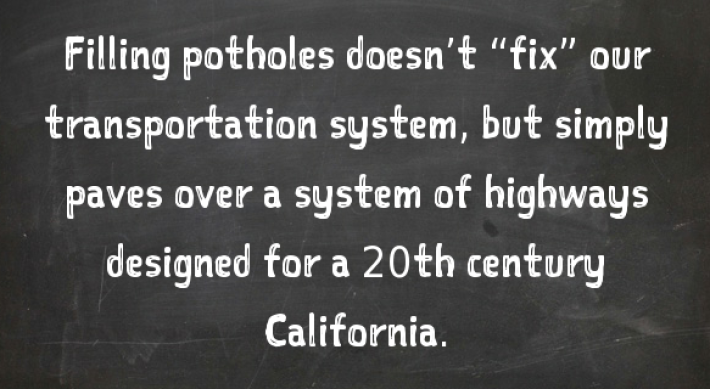An op-ed piece in the Sacramento Bee this morning points out the strange disconnects in current legislative discussions on funding transportation.
Authors Jeanie Ward-Waller, policy director of the California Bicycle Coalition, and Chanell Fletcher, senior California policy manager for the Safe Routes to School National Partnership, point out that “two deeply intertwined debates are underway in their usual separate silos in the Legislature.”
Those two separate discussions are about reducing carbon emissions—by, among other things, cutting petroleum use in half – and the special session on transportation infrastructure. The focus of the special session, say the authors, “has been on filling potholes and adding new highway lanes to move more trucks.”
But, they say, “the hard truth is we can’t tackle climate change without dealing with transportation” because transportation accounts for such a large portion of greenhouse gas emissions in California.
Filling potholes doesn’t “fix” our transportation system, but simply paves over a system of highways designed for a 20th century California. Building more highways doesn’t fix our congestion problem. Studies show that the new lanes will just fill up with more cars and trucks as our population and economy continue to grow, and then be marked with potholes in another ten years.
How can we significantly cut petroleum use if we only invest in solutions that add more cars and trucks on our roads? Encouraging consumers to buy electric vehicles will help but will only get us part way.
The solutions “include improving and expanding transit service so buses and trains are convenient, reliable and affordable, especially for commuters who can’t afford a car” and “networks of protected bike lanes and sidewalks to connect neighborhoods to transit, schools, parks, shopping and work so families don’t need a car for every trip.”
These solutions are also climate solutions. They create healthier, more vibrant communities and reduce the cost of transportation for families. Plus, fewer cars on the road means fewer potholes to repair ten years from now.
The authors are part of a coalition calling for increased transit funding and for making it safer and more convenient to walk or ride bikes to connect with transit.






